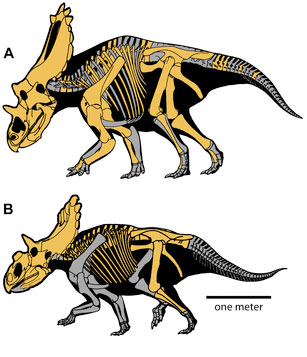Scientists discovered two previously unknown species of dinosaur in southern Utah, reports the Associated Press. The species are described in the current issue of the journal PLoS ONE.
Both species are closely related to the Triceratops. One, Kosmoceratops richardsoni, had 15 horns on its head, while the other, Utahceratops gettyi, had five.
Kosmoceratops richardsoni was larger, attaining a length of 18 to 22 feet and a weight of three to four tons. Its skill was roughly seven feet long and it foot about six feet tall.
 Skeletal elements recovered for Utahceratops gettyi n. gen et n. sp. and Kosmoceratops richardsoni n. gen et n. sp. Utahceratops gettyi is known from six specimens, including two partial skulls, which together preserve about 96% of the skull and 70% of the postcranial skeleton. Highlighted elements are preserved. Kosmoceratops richardsoni is known from four specimens, one of which preserves a nearly complete skull and 45% of the postcranium. Scale bar represents one meter. Image and caption courtesy of Sampson et al. (2010). |
Utahceratops gettyi weighted about 2.5 tons and attained a length of 15 feet.
The fossils were discovered in Grand Staircase-Escalante National Monument, a 1.9 million acre expanse of desert in southern Utah. The dinosaurs roamed the region, which was swampy and part of the ancient continent of Laramidia, some 74 to 77 million years ago.
The researchers say the findings lend support to the hypothesis that centers of high dinosaur endemism existed within continents during the period.
Sampson SD, Loewen MA, Farke AA, Roberts EM, Forster CA, et al. (2010) New Horned Dinosaurs from Utah Provide Evidence for Intracontinental Dinosaur Endemism. PLoS ONE 5(9): e12292. doi:10.1371/journal.pone.0012292